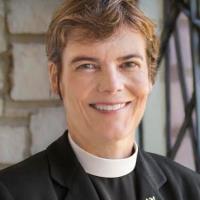Commentary on Mark 1:4-11
The account of Jesus’ baptism in the gospel of Mark is read and heard on the second Sunday of Epiphany, a season that expands and unfolds the birth of Jesus highlighting themes of mission to the Gentiles, vision, sight, and light.
The second Sunday, the Baptism of Our Lord, commemorates the occasion when Jesus’ role and ministry is made manifest. Many churches schedule public baptisms on that day for adults, children, and infants. Congregations are conditioned to seeing a sharp contrast between the ministry of John and of Jesus and between the John’s baptism of sinners and the baptism of the sinless Jesus.
The cultural calendar observes the “new year” with celebrations on New Year’s Eve and New Year’s Day. Newspapers feature reviews of celebrities who have died in the past year, and people make unrealistic New Year’s resolutions that are forgotten by the end of the month of January. “Sin” is rarely evoked as a category with which to interpret reality, and repentance is an unpopular notion in a no-fault world.
The world of the text
In the narrative arc of the gospel of Mark, the passage comes just after the announcement of the “beginning of the good news”; the reference to writing (as it is written) and the “sound” of a voice crying from the citation of Isaiah the prophet. The narrator notes John’s location in the wilderness and summarizes content of his preaching (“proclaiming”) repentance for the forgiveness of sins. People from the country and the city flock to the river. The text emphasizes the great number with the repetition of pasa (Judea) and pantes (Jerusalemites). The narrator notes John’s clothing and diet and quotes John’s proclaiming the coming of a more powerful one who will baptize with the Holy Spirit.
As in the preceding scene, Jesus’ place of origin is also named — “from Nazareth in Galilee” The sentences begin with the same word egeneto “it happened” Mark 1:4, 1:9, 1:11 an intransitive verb “to be.” The New Revised Standard Version diminishes the repetition by translating, John “appeared,” Jesus “came,” and a voice “came.” The narrator tells what Jesus sees “the heavens torn open and the spirit descending in the form of a dove” and what he hears a voice from heaven say, “you are my son, the beloved, with you I am well pleased.” Without a birth narrative, this is the first appearance of Jesus in the gospel of Mark. In Mark, Jesus has no backstory and no pedigree. His baptism is God’s “adoption” of Jesus, as he adopts the king as his son in Psalm 2:7.
The details and word choices of the text evoke scriptural allusions and create a web of associations within the gospel of Mark. The “voice” written in the prophet Isaiah (Mark 1:3) is followed immediately by the proclamation of John, then by the “voice” from heaven. The “wilderness” where the voice cries is repeated as the geographical location of John. The wilderness is where Jesus is thrown by the spirit to be tempted (Mark 1:12), goes to pray (eremos, Mark 1:35) and where he feeds the hungry (Mark 6:31). John is described as an ascetic figure resembling Elijah, the northern prophet. John’s words about a “mightier one” sets up the theme of power, mentioned in the parable of the strong man, bound by a stronger one (Mark 3:27) and developing through the gospel in the struggle between Jesus’ power and the power of evil.
The word “torn open” (schizo) used of the heavens occurs again in Mark 15:38 implying a connection between the baptism and crucifixion. The announcement “you are my son,” is one of three moments in the gospel where Jesus is proclaimed “son” — here, at the transfiguration (Mark 9:7), and at the crucifixion (Mark 15:39). The water and the dove evoke the creation story in Genesis 1, the “beginning” of the scriptures. Mark stresses the continuity of the ministry of John and Jesus with the identical introduction, egeneto, the use of the verb “proclaim” for each and the command in Jesus first sermon (Mark 1:14) to “repent.” At one other key juncture in the gospel, James and John’s request to sit at Jesus right and left hand, Jesus associates his baptism with his suffering and death, “are you able to drink the cup that I drink, or be baptized with the baptism with which I am baptized?”
The world behind the text
One of the undisputed facts in historical Jesus research is the baptism of Jesus by John. For Jesus to have been baptized by John suggests that he was a follower of John or a participant in the movement of John for which baptism in water for repentance was the ritual/prophetic sign. All four gospels explain in different ways how Jesus could have been baptized by John and yet be greater. Mark here implies identification with John as the messenger and one who cries out in the wilderness. Historically, Jesus’ baptism was not Christian baptism. Jesus’ “sinlessness” is not an issue for Mark. By the time of Mark’s account the baptismal practice of the earliest church most likely did shape the way baptism is understood in the gospel.
Bringing the text into the present world
The most powerful preaching on Mark in Year B will harness the power, clarity, and authority of Mark’s narrative, the distinctive word choices, evocative imagery from Israel’s sacred text and will preach each episode in the wider narrative arc of the whole gospel. Within the beginning of the gospel, the baptism, the exultant proclamation of Jesus as God’s son, is the reality of Jesus’ death. In the empty tomb, at the end of the gospel, the followers of Jesus are sent meet him in Galilee where the gospel began. Mark’s vision is austere and paradoxical, often troubling, while ultimately affirming human faithfulness and the life giving power of the resurrection.
Any one of the resonant words that occur in this text and echo through the gospel can be brought to life by the imagination of the preacher in the lives of her hearers: “voice,” “wilderness,” “torn,” “son.”
The particular power of Mark’s account of John’s baptism of all the people and the extraordinary vision that Jesus receives to initiate his ministry can be read in creative tension with the occasion of baptism celebrated in the liturgy of the day.
Preachers may invite the hearers to explore what kind of beginning is this for Jesus and for the children who are being baptized. How is it like and unlike the beginning of the calendar year, all those journalistic predictions, the resolutions to lose weight and get more sleep? How is the beginning of a new life, a new “way,” the way of the Lord?
We associate beginning and babies with new life and ongoing life. The close association of baptism with death in Mark opens up and expands the understanding of the baptism of these babies and adults. It is baptism into the death and resurrection of Jesus. Suffering and loss are sewn into the fabric of this way of life.
How is repentance a life-giving invitation for the twenty first century? All those people in the Jordan were being dipped in water to signify a movement they were joining — John’s movement of repentance and the forgiveness of sin. What movement of justice or returning to God are we joining when we reaffirm our baptism? Mark reaffirms the covenant values of love of God and love of neighbor (Mark 11:28-34). What does that look like? The crossing of the Jordan meant the liberation of the people and their entry into the promised land. How is baptism liberation?
How are John and Jesus “brothers” in the movement of justice and liberation? What will baptism with the Holy Spirit mean?
What challenges are in store for Jesus, the beloved Son? God called Jesus to a unique role at his baptism. What is the role in the world of Christians who are baptized?
Mark’s gospel provokes the imagination of the preacher and of the reader. What does Jesus see when the heavens are torn open? Why is the word so violent? What is the reader of the gospel going to see in the course of the story? What will the newly baptized and their sponsors and godparents see in the suffering, broken, and redeemed world they walk into when they leave the sanctuary?


January 7, 2018